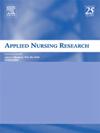Effects of a 12-week lower limb resistance training with breathing regulation in patients with diabetes-related foot ulcers: A randomized controlled trial
IF 2.2
4区 医学
Q1 NURSING
引用次数: 0
Abstract
Patients with diabetes-related foot ulcers may require hospitalization and face an increased risk of amputation, which can significantly impact their quality of life. One potential solution is exercise, which can regulate blood glucose levels, improve wound healing, and enhance overall well-being. This randomized controlled trial aimed to evaluate the impact of a lower limb resistance training program combined with breathing-regulation techniques on glycemic control, wound healing, and quality of life in patients with diabetes-related foot ulcers. Patients hospitalized for type 2 diabetes-related foot ulcers were recruited from a single medical center and randomly divided into two groups. The control group (n = 31) received standard treatment, while the exercise group (n = 28) received standard treatment along with lower limb resistance training and breathing-regulation techniques. Assessments of fasting blood glucose levels, hemoglobin A1c (HbA1c) levels, wound healing, and quality of life were carried out at the start of the study and week 4, week 8, and week 12 of the intervention. The exercise group demonstrated significant improvements in fasting blood glucose and HbA1c levels, as well as in physical health, psychological well-being, social relationships, and environmental aspects of quality of life over the 12 weeks compared to both the control group and the baseline (p < .05). However, no significant change was observed in wound healing (p > .05). The resistance training program for the lower limbs, combined with breathing-regulation techniques, is recommended for improving blood glucose levels and quality of life over 12 weeks.
12周下肢阻力训练与呼吸调节对糖尿病相关足溃疡患者的影响:一项随机对照试验
患有糖尿病相关足部溃疡的患者可能需要住院治疗,并面临截肢的风险增加,这可能严重影响他们的生活质量。一个潜在的解决方案是运动,它可以调节血糖水平,促进伤口愈合,提高整体健康水平。这项随机对照试验旨在评估下肢阻力训练计划结合呼吸调节技术对糖尿病相关足部溃疡患者血糖控制、伤口愈合和生活质量的影响。因2型糖尿病相关足部溃疡住院的患者从单一医疗中心招募,随机分为两组。对照组(n = 31)采用标准治疗,运动组(n = 28)采用标准治疗,同时进行下肢阻力训练和呼吸调节技术。在研究开始时以及干预的第4周、第8周和第12周进行空腹血糖水平、血红蛋白A1c (HbA1c)水平、伤口愈合和生活质量的评估。与对照组和基线相比,运动组在12周内表现出空腹血糖和HbA1c水平的显著改善,以及身体健康、心理健康、社会关系和生活质量的环境方面(p <;. 05)。然而,在伤口愈合方面没有观察到明显的变化(p >;. 05)。建议将下肢阻力训练项目与呼吸调节技术相结合,在12周内改善血糖水平和生活质量。
本文章由计算机程序翻译,如有差异,请以英文原文为准。
求助全文
约1分钟内获得全文
求助全文
来源期刊

Applied Nursing Research
医学-护理
CiteScore
4.50
自引率
0.00%
发文量
65
审稿时长
70 days
期刊介绍:
Applied Nursing Research presents original, peer-reviewed research findings clearly and directly for clinical applications in all nursing specialties. Regular features include "Ask the Experts," research briefs, clinical methods, book reviews, news and announcements, and an editorial section. Applied Nursing Research covers such areas as pain management, patient education, discharge planning, nursing diagnosis, job stress in nursing, nursing influence on length of hospital stay, and nurse/physician collaboration.
 求助内容:
求助内容: 应助结果提醒方式:
应助结果提醒方式:


